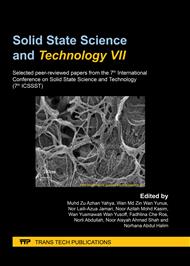[1]
Y. Kato, S. Hori, T. Saito, K. Suzuki, M. Hirayama, A. Mitsui, M. Yonemura, H. Iba, R. Kanno, High-power all-solid-state batteries using sulfide superionic conductors, Nature Energy 1 (2016) 16030.
DOI: 10.1038/nenergy.2016.30
Google Scholar
[2]
Xue, Z., D. He, X. Xie, Poly (ethylene oxide)-based electrolytes for lithium-ion batteries, Journal of Materials Chemistry A 3 (2015) 19218-19253.
DOI: 10.1039/c5ta03471j
Google Scholar
[3]
A. Samsudin, W.M. Khairul, M. Isa, Characterization on the potential of carboxy methylcellulose for application as proton conducting biopolymer electrolytes, Journal of Non-crystalline Solids 358 (2012) 1104-1112.
DOI: 10.1016/j.jnoncrysol.2012.02.004
Google Scholar
[4]
N.I. Harun, R.M. Ali, A.M.M. Ali, M.Z.A. Yahya, Dielectric behaviour of cellulose acetate-based polymer electrolytes, Ionics 18 (2012) 599-606.
DOI: 10.1007/s11581-011-0653-0
Google Scholar
[5]
N.A.N. Aziz, N.K. Idris, M.I.N. Isa, Proton conducting polymer electrolytes of methycellulose doped ammonium fluoride: Conductivity and ionic transport studies, International Journal of the Physical Science 5(6) (2010) 748-752.
Google Scholar
[6]
X.H. Flora, M. Ulaganathan, S. Rajendran, Influence of lithium salt concentration on PAN-PMMA blend polymer electrolytes, Int. J. Electrochem. Sci. 7 (2012) 7451-7462.
Google Scholar
[7]
M.N. Hafiza, M.I.N. Isa, Ionic conductivity and conduction mechanism studies of CMC/chitosan biopolymer blend electrolytes, Research Journal of Recent Sciences 3(11) (2014) 50-56.
Google Scholar
[8]
M.A. Ramlli, M.I.N. Isa, Conductivity study of carboxyl methyl cellulose solid biopolymer electrolytes (SBE) doped with ammonium fluoride, Research Journal of Recent Sciences 3(6) (2014) 59-66.
Google Scholar
[9]
S.S. Alias, A.A. Mohamad, Effect of NH4I and I2 concentration on agar gel polymer electrolyte properties for a dye-sensitized solar cell, Ionics 19 (2013) 1185-1194.
DOI: 10.1007/s11581-012-0840-7
Google Scholar
[10]
W. Wang, X. Guo, Y. Yang, Lithium iodide effect on the electrochemical behavior of agarose based polymer electrolyte for dye-sensitized solar cell, Electrochimica Acta 56 (2011) 7347-7351.
DOI: 10.1016/j.electacta.2011.06.032
Google Scholar
[11]
Y. Yang, H. Hu, Z. Cong-Hua, S. Xu, B. Sebo, Z. Xing-Zhong, Novel agarose polymer electrolyte for quasi-solid state dye-sensitized solar cell, Journal of Power Sources 196 (2011) 2410-2415.
DOI: 10.1016/j.jpowsour.2010.10.067
Google Scholar
[12]
K. Sankar, R. Rajasekaran, V. Vetrivelan, Synthesis, Growth and Characterization of Glycine Ammonium Bromide: A potential NLO material, Materials Today: Proceedings 8 (2019) 332-336.
DOI: 10.1016/j.matpr.2019.02.119
Google Scholar
[13]
P. Geetha, S. Krishnan, S. Jeromdas, V.Chithambaram, Growth and characterization of urea ammonium bromide nonlinear optical single crystals by slow evaporation technique, Optik 126(23) (2015) 3962-3964.
DOI: 10.1016/j.ijleo.2015.07.181
Google Scholar
[14]
A.M.S. Nurhaziqah, I.Q. Afiqah, M.F.H. Abd. Aziz, N.A. Nik Aziz, S. Hasiah, Optical, structural and electrical studies of biopolymer electrolytes based on methylcellulose doped with Ca(NO3)2, IOP Conference Series: Materials Science and Engineering 440 (2018) 012034.
DOI: 10.1088/1757-899x/440/1/012034
Google Scholar
[15]
F. Bella, N.N. Mobarak, F.N. Jumaah, A. Ahmad, From seaweeds to biopolymeric electrolytes for third generation solar cells: an intriguing approach, Electrochimica Acta 151 (2015) 306-311.
DOI: 10.1016/j.electacta.2014.11.058
Google Scholar
[16]
R. Singh, B. Bhattacharya, R. Hee-Woo, P.K. Singh, New biodegradable polymer electrolyte for dye sensitized solar cell, Int. J. Electrochem. Sci. 9(5) (2014) 2620-2630.
Google Scholar
[17]
S.B. Aziz, Z.H.Z. Abidin, Ion‐transport study in nanocomposite solid polymer electrolytes based on chitosan: Electrical and dielectric analysis, Journal of Applied Polymer Science (2015) 41774.
DOI: 10.1002/app.41774
Google Scholar
[18]
N. Zebardastan, M.H. Khanmirzaei, S. Ramesh, K. Ramesh, Performance enhancement of poly (vinylidene fluoride-co-hexafluoro propylene)/polyethylene oxide based nanocomposite polymer electrolyte with ZnO nanofiller for dye-sensitized solar cell, Organic Electronics 49 (2017) 292-299.
DOI: 10.1016/j.orgel.2017.06.062
Google Scholar
[19]
E. Raphael, C.O. Avellaneda, B. Manzolli, A. Pawlicka, Agar-based films for application as polymer electrolytes, Electrochimica Acta 55 (2010) 1455-1459.
DOI: 10.1016/j.electacta.2009.06.010
Google Scholar
[20]
Y. Ding, G. Yu, A Bio‐Inspired, Heavy‐Metal‐Free, Dual‐Electrolyte Liquid Battery towards Sustainable Energy Storage, Angewandte Chemie International Edition 55 (2016) 4772-4776.
DOI: 10.1002/anie.201600705
Google Scholar


